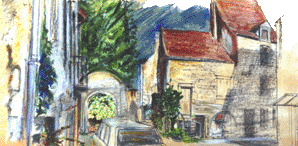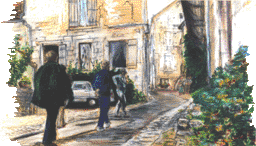The thirteenth century was a sort of golden age for secular architecture; St Genès was rebuilt (and completed in the fifteenth century with remarkable tribune galleries including a flamboyant gothic pulpit, and beautifully carved choir stalls intended for the use of the Brotherhood of the Gentlemen of St. Genès; the lovely “Angel of the Annunciation” also dates from the fifteenth century).

[the English translator, on the other hand, inhabits an eighteenth century house of no known historical importance across the street]…
![]()
Major works of construction and fortification went on throughout the fourteenth and fifteenth century. The Porte du Bourg and its drawbridge were built in the mid-fifteenth century, and several houses with cut stone stair-towers show the influence of the Renaissance.
During the Wars of Religion, Flavigny played an important role. Between 1589 and 1592, Henry III made it the headquarters of the loyalist Burgundian parliament, which opposed the rebel League parliament established in Dijon.

In the eighteenth century, Claude Coutier, marquis de Souhey, governor of Flavigny built a magnificent chateau for himself overlooking a series of terasses overlooking the valley of the Verpant, and bankrupted himself in the process. The commendatory abbot remodeled the façade of the Abbot’s Residence in the style of the time, adding a portico and terasses overlooking the valley of the Recluse on the other side of the town. Even the abbey itself was remodeled, and in fact the eighteenth century wing survives to this day.